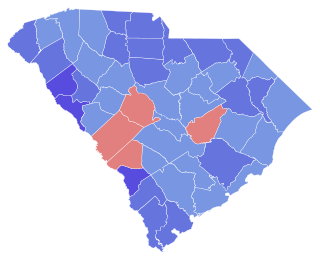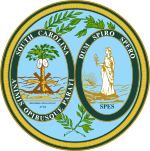
The 1922 South Carolina gubernatorial election was held on November 7, 1922, to select the governor of the state of South Carolina. Thomas Gordon McLeod won the Democratic primary and ran unopposed in the general election becoming the 95th governor of South Carolina.

The 1924 South Carolina gubernatorial election was held on November 4, 1924, to select the governor of the state of South Carolina. Governor Thomas Gordon McLeod won the Democratic primary and ran unopposed in the general election being reelected for a second two-year term.

The 1930 South Carolina gubernatorial election was held on November 4, 1930, to select the governor of the state of South Carolina. Ibra Charles Blackwood won the contested Democratic primary and ran unopposed in the general election becoming the 97th governor of South Carolina.

The 1934 South Carolina gubernatorial election was held on November 6, 1934, to select the governor of the state of South Carolina. Olin D. Johnston won the contested Democratic primary and ran unopposed in the general election becoming the 98th governor of South Carolina.

The 1938 South Carolina gubernatorial election was held on November 8, 1938, to select the governor of the state of South Carolina. Burnet Rhett Maybank, Mayor of Charleston, South Carolina, won the contested Democratic primary and defeated Republican Joseph Augustis Tolbert in the general election becoming the 99th governor of South Carolina.

The 1942 South Carolina gubernatorial election was held on November 3, 1942, during World War II, to select the Governor of South Carolina. Olin D. Johnston won the Democratic primary and ran without opposition in the general election on account of South Carolina's effective status as a one-party state, winning a second non-consecutive term as Governor of South Carolina.

The 1946 South Carolina gubernatorial election was held on November 5, 1946 to select the governor of the state of South Carolina. Strom Thurmond won the contested Democratic primary and ran unopposed in the general election becoming the 103rd governor of South Carolina.

The 1950 South Carolina gubernatorial election was held on November 7, 1950, to select the governor of the state of South Carolina. James F. Byrnes won the Democratic primary and ran unopposed in the general election becoming the 104th governor of South Carolina.

The 1958 South Carolina gubernatorial election was held on November 4, 1958 to select the governor of the state of South Carolina. Ernest Hollings won the Democratic primary against rival Donald S. Russell and ran unopposed in the general election becoming the 106th governor.

The 1966 South Carolina gubernatorial election was held on November 8, 1966, to select the governor of the state of South Carolina, US. It marked the first time since the gubernatorial election of 1938 that the Democratic candidate faced opposition from a Republican candidate. Governor Robert Evander McNair prevailed as the winner of the election and continued as the 108th governor of South Carolina, but Joseph O. Rogers, Jr. had a respectable showing for the first Republican candidate in 28 years.

The 1974 South Carolina gubernatorial election was held on November 5, 1974 to select the governor of the state of South Carolina. Initially considered a longshot candidate, Republican James B. Edwards defeated Democrat W. J. Bryan Dorn with a narrow majority of the vote.

The 1888 South Carolina gubernatorial election was held on November 6, 1888, to select the governor of the state of South Carolina. John Peter Richardson III was renominated by the Democrats and was reelected for a second two-year term.

The 1896 South Carolina gubernatorial election was held on November 3, 1896 to select the governor of the state of South Carolina. William Haselden Ellerbe won the Democratic primary and easily won the general election to become the 86th governor of South Carolina.

The 1910 South Carolina gubernatorial election was held on November 8, 1910, to select the governor of the state of South Carolina. Coleman Livingston Blease won the Democratic primary and ran unopposed in the general election to become the 90th governor of South Carolina.
The 1912 South Carolina gubernatorial election was held on November 5, 1912, to select the governor of the state of South Carolina. Governor Coleman Livingston Blease won the Democratic primary. As South Carolina was utterly dominated by the Democratic Party, he faced no significant opposition in the general election.

The 1914 South Carolina gubernatorial election was held on November 3, 1914, to select the governor of the state of South Carolina. Richard Irvine Manning III emerged from the crowded Democratic primary to win in the runoff and overwhelmingly won the effectively one-party state's general election to become the 92nd governor of South Carolina.

The 1916 South Carolina gubernatorial election was held on November 7, 1916, to select the governor of the state of South Carolina. Governor Richard Irvine Manning III faced a strong challenge from former governor Coleman Livingston Blease in the Democratic primary, but Manning won a second two-year term as governor.

The 1918 South Carolina gubernatorial election was held on November 5, 1918, to select the governor of the state of South Carolina. Robert Archer Cooper emerged from the crowded Democratic primary and ran unopposed in the one-party state's general election to become the 93rd governor of South Carolina.

The 1918 South Carolina United States Senate election was held on Tuesday, November 5, simultaneously with the special senate election to elect the United States Senator for a six-year term from South Carolina. Nathaniel B. Dial won the Democratic primary and was unopposed in the general election to win the six-year term to the Senate.

Elections were held in South Carolina on Tuesday, November 2, 2010. Primary elections were held on June 8, 2010, and a run-off election for certain contests was held on June 22, 2010.












